Gabriel Revel (10 May 1643 - 9 July 1712) was a French painter. [1]
Contents

Gabriel Revel (10 May 1643 - 9 July 1712) was a French painter. [1]

He was born in Château-Thierry, in a family of artists. He went to Paris, probably on the advice of Jean de La Fontaine. He joined the group of decorative artists working for Louis XIV, including François Verdier, Claude II Audran et François Bonnemer, on the Soleil Royal . It is thought that he worked with Charles Le Brun at the Palace of Versailles.
Probably after a voyage to Italy, Revel was accepted into the Académie Royale on 31 January 1682 on the basis of his portraits of François Girardon and Michel Anguier. [2] [3] For the city of Dijon in 1688 he painted the ceiling of the Chambre des requêtes in the Parlement de Bourgogne, with an Allegory of Justice. Moving to Dijon in 1692 he produced a large number of historical paintings and portraits.
He died at Dijon.
One of Revel's paintings, now titled Portrait of an Astronomer (circa 1670), was thought to be a portrait of philosopher René Descartes by Pierre Mignard and was gifted to the National Gallery by Lady Carlisle in 1913. [4]

François Boucher was a French painter, draughtsman and etcher, who worked in the Rococo style. Boucher is known for his idyllic and voluptuous paintings on classical themes, decorative allegories, and pastoral scenes. He was perhaps the most celebrated painter and decorative artist of the 18th century.
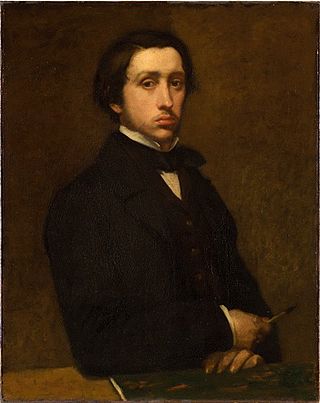
Edgar Degas was a French Impressionist artist famous for his pastel drawings and oil paintings.

The Mona Lisa is a half-length portrait painting by Italian artist Leonardo da Vinci.

Alphonse Legros was a French, later British, painter, etcher, sculptor, and medallist. He moved to London in 1863 and later took British citizenship. He was important as a teacher in the British etching revival.

Jean Désiré Gustave Courbet was a French painter who led the Realism movement in 19th-century French painting. Committed to painting only what he could see, he rejected academic convention and the Romanticism of the previous generation of visual artists. His independence set an example that was important to later artists, such as the Impressionists and the Cubists. Courbet occupies an important place in 19th-century French painting as an innovator and as an artist willing to make bold social statements through his work.
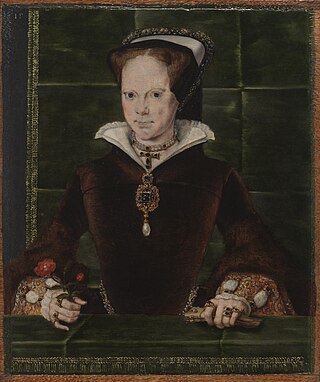
Hans Eworth was a Flemish painter active in England in the mid-16th century. Along with other exiled Flemings, he made a career in Tudor London, painting allegorical images as well as portraits of the gentry and nobility. About 40 paintings are now attributed to Eworth, among them portraits of Mary I and Elizabeth I. Eworth also executed decorative commissions for Elizabeth's Office of the Revels in the early 1570s.

Robert Campin, now usually identified with the Master of Flémalle, was the first great master of Early Netherlandish painting. While the existence of a highly successful painter called Robert Campin is relatively well documented for the period, no works can be certainly identified as by him through a signature or contemporary documentation. A group of paintings, none dated, have been long attributed to him, and a further group were once attributed to an unknown "Master of Flémalle". It is now usually thought that both groupings are by Campin, but this has been a matter of some controversy for decades.

Jean-Honoré Fragonard was a French painter and printmaker whose late Rococo manner was distinguished by remarkable facility, exuberance, and hedonism. One of the most prolific artists active in the last decades of the Ancien Régime, Fragonard produced more than 550 paintings, of which only five are dated. Among his most popular works are genre paintings conveying an atmosphere of intimacy and veiled eroticism.

Jean-Jacques Henner was a French painter, noted for his use of sfumato and chiaroscuro in painting nudes, religious subjects and portraits.
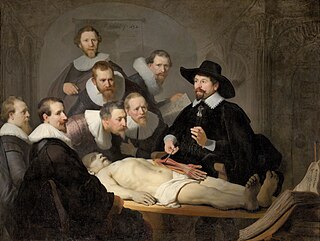
The Anatomy Lesson of Dr. Nicolaes Tulp is a 1632 oil painting on canvas by Rembrandt housed in the Mauritshuis museum in The Hague, the Netherlands. It was originally created to be displayed by the Surgeons Guild in their meeting room. The painting is regarded as one of Rembrandt's early masterpieces.
Events from the year 1793 in art.
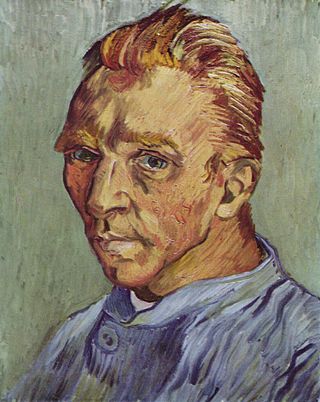
A self-portrait is a representation of an artist that is drawn, painted, photographed, or sculpted by that artist. Although self-portraits have been made since the earliest times, it is not until the Early Renaissance in the mid-15th century that artists can be frequently identified depicting themselves as either the main subject, or as important characters in their work. With better and cheaper mirrors, and the advent of the panel portrait, many painters, sculptors and printmakers tried some form of self-portraiture. Portrait of a Man in a Turban by Jan van Eyck of 1433 may well be the earliest known panel self-portrait. He painted a separate portrait of his wife, and he belonged to the social group that had begun to commission portraits, already more common among wealthy Netherlanders than south of the Alps. The genre is venerable, but not until the Renaissance, with increased wealth and interest in the individual as a subject, did it become truly popular.

No contemporary physical description of William Shakespeare is known to exist. The two portraits of him that are the most famous are the engraving that appears on the title-page of the First Folio, published in 1623, and the other is the sculpture that adorns his memorial in Stratford upon Avon, which dates from before 1623. Experts and critics have argued that several other paintings from the period may represent him, and more than 60 portraits purporting to be of Shakespeare were offered for sale to the National Portrait Gallery within four decades of its foundation in 1856, but in none of them has Shakespeare's identity been proven.

The artists of the Tudor court are the painters and limners engaged by the monarchs of England's Tudor dynasty and their courtiers between 1485 and 1603, from the reign of Henry VII to the death of Elizabeth I.
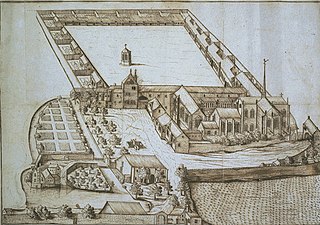
The Chartreuse de Champmol, formally the Chartreuse de la Sainte-Trinité de Champmol, was a Carthusian monastery on the outskirts of Dijon, which is now in France, but in the 15th century was the capital of the Duchy of Burgundy. The monastery was founded in 1383 by Duke Philip the Bold to provide a dynastic burial place for the Valois Dukes of Burgundy, and operated until it was dissolved in 1791, during the French Revolution.

The Musée Magnin is a national museum in the French city of Dijon in Burgundy, in the Côte-d'Or department, with a collection of around 2,000 works of art collected by Maurice Magnin and his sister Jeanne and bequeathed to the state in 1938 along with the hôtel Lantin, a 17th-century hôtel particulier in the old-town quarter of Dijon where it is now displayed as an amateur collector's cabinet of curiosities and as the Magnin family home.

Portrait of Margaret van Eyck is a 1439 oil on wood painting by the Early Netherlandish master Jan van Eyck. It is one of the two latest of his surviving paintings, and one of the earliest European artworks to depict a painter's spouse. Completed when she was around 34, it was hung until the early 18th century in the Bruges chapel of the Guild of painters. The work is thought to be a pendant or diptych panel for either a now lost self-portrait known from records until 1769, or of Jan van Eyck's likely self-portrait now in the National Gallery in London.
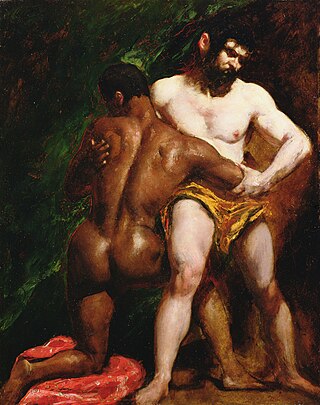
The Wrestlers is an oil painting on millboard by English artist William Etty, painted around 1840 and currently in the York Art Gallery, in York, England. It depicts a wrestling match between a black man and a white man, both glistening with sweat and under an intense light emphasising their curves and musculature. While little documentation of the painting exists prior to 1947, it is likely that it was painted over a period of three evenings at the life class of the Royal Academy.

Self-Portrait with Halo and Snake, also known as Self-Portrait, is an 1889 oil-on-wood painting by French artist Paul Gauguin, which represents his late Brittany period in the fishing village of Le Pouldu in northwestern France. No longer comfortable with Pont-Aven, Gauguin moved on to Le Pouldu with his friend and student Meijer de Haan and a small group of artists. He stayed for several months in the autumn of 1889 and the summer of 1890, where the group spent their time decorating the interior of Marie Henry's inn with every major type of art work. Gauguin painted his Self-Portrait in the dining room with its companion piece, Portrait of Jacob Meyer de Haan (1889).

Hans Holbein the Younger painted the Portrait of Erasmus of Rotterdam several times, and his paintings were much copied, at the time and later. It is difficult to disentangle Holbein's original work from that of his workshop and other copyists. Possibly five largely original versions survive, as well as a number of drawings made as studies.